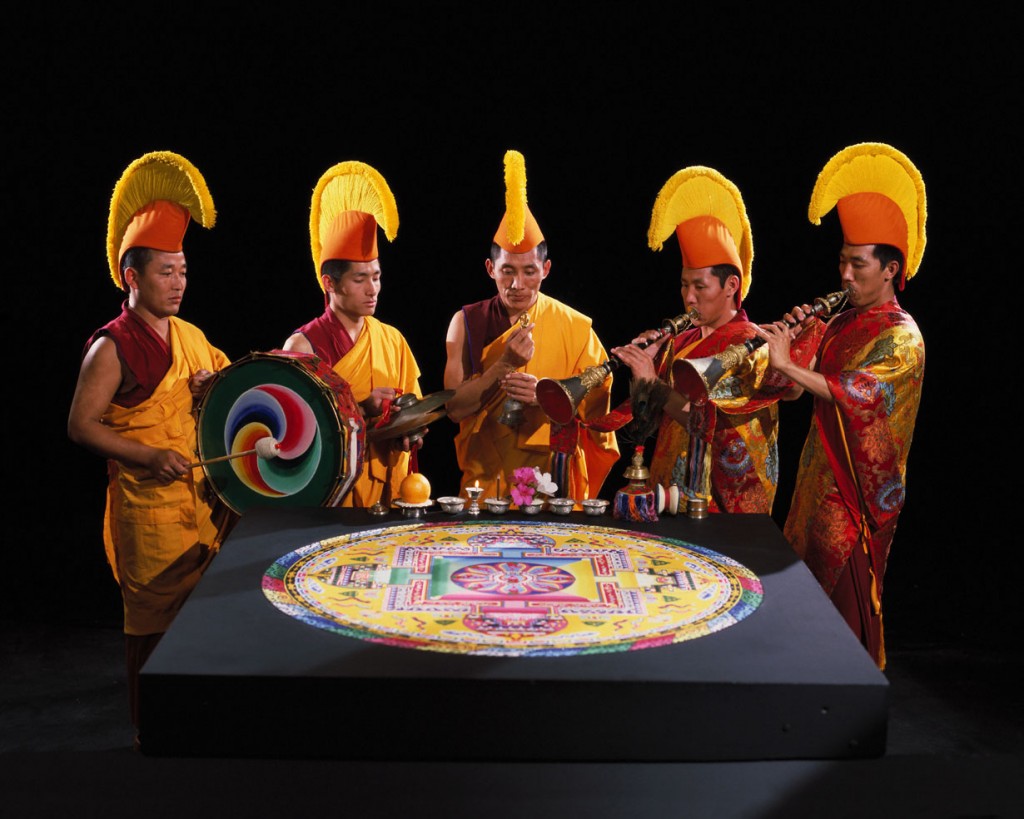 Tibetan Buddhist monks from Drepung Loseling Monastery will construct a Mandala Sand Painting from April 14 -19, 2014 at the Dennos Museum Center of Northwestern Michigan College beginning with an opening ceremony on Monday April 14 at noon in the Zimmerman court.
Tibetan Buddhist monks from Drepung Loseling Monastery will construct a Mandala Sand Painting from April 14 -19, 2014 at the Dennos Museum Center of Northwestern Michigan College beginning with an opening ceremony on Monday April 14 at noon in the Zimmerman court.
They will offer a concert of sacred music and dance in Milliken Auditorium at 8 PM on Saturday April 19 after which the Mandala Sand Painting will be swept up and the sand distributed to concert attendees. Tickets are $25 advance, $28 at the door and $22 for museum members plus fees. Tickets may be purchased by calling the Museum Box office at 231-995-1553 or on line at www.dennosmuseum.org, also at 1-800-836-0717 or www.MyNorthTickets.com.
From all the artistic traditions of Tantric Buddhism, that of painting with colored sand ranks as one of the most unique and exquisite. Millions of grains of sand are painstakingly laid into place on a flat platform over a period of days or weeks to form the image of a mandala. To date the monks have created mandala sand paintings in more than 100 museums, art centers, and colleges and universities in the United States and Europe.
Mandala is a Sanskrit word meaning sacred cosmogram. These cosmograms can be created in various media, such as watercolor on canvas, wood carvings, and so forth. However, the most spectacular and enduringly popular are those made from colored sand.
In general all mandalas have outer, inner and secret meanings. On the outer level they represent the world in its divine form; on the inner level they represent a map by which the ordinary human mind is transformed into enlightened mind; and on the secret level they depict the primordially perfect balance of the subtle energies of the body and the clear light dimension of the mind. The creation of a sand painting is said to effect purification and healing on these three levels.
The mandala sand painting begins with an opening ceremony, during which the lamas consecrate the site and call forth the forces of goodness. This is done by means of chanting, music and mantra recitation, and will be held on Monday, April 14 at 12:00 noon.
The lamas begin the exhibit by drawing an outline of the mandala on the wooden platform. On the following days they lay the colored sands. Each monk holds a traditional metal funnel called a chakpur while running a metal rod on its grated surface. The vibration causes the sands to flow like liquid onto the platform.
Traditionally most sand mandalas are destroyed shortly after their completion. This is done as a metaphor for the impermanence of life. The sands are swept up and placed in an urn; to fulfill the function of healing, half is distributed to the audience at the closing ceremony, while the remainder is carried to a nearby body of water, where it is deposited. The waters then carry the healing blessing to the ocean, and from there it spreads throughout the world for planetary healing. The closing ceremony will be held on Saturday April 19 at the close of the concert performance of sacred music and dance to be held in Milliken Auditorium at 8 PM that evening featuring the famed multiphonic singers of Tibet’s Drepung Loseling Monastery, whose sellout performances in Carnegie Hall and Lincoln Center received national acclaim.
The Mystical Arts of Tibet tour is co-produced by Richard Gere Productions and Drepung Loseling Institute, the North American Seat of Drepung Loseling Monastery, India. Endorsed by His Holiness the Dalai Lama, the tour has three basic purposes: to make a contribution to world peace and healing; to generate a greater awareness of the endangered Tibetan civilization; and to raise support for the Tibetan refugee community in India.
The performance features multiphonic singing, wherein the monks simultaneously intone three notes of a chord. The Drepung Loseling monks are particularly renowned for this unique singing. They also utilize traditional instruments such as 10-foot long dung-chen horns, drums, bells, cymbals and gyaling trumpets. Rich brocade costumes and masked dances, such as the Dance of the Sacred Snow Lion, add to the exotic splendor.
The monks of Drepung Loseling have a very distinguished modern-day musical history. On past tours they have performed with Kitaro, Paul Simon, Philip Glass, Eddie Brickell, Natalie Merchant, Patti Smith, the Beastie Boys, and the Grateful Dead’s Mickey Hart, to name but a few.
In addition, two of their recordings achieved top-10 listings on the New Age charts: Tibetan Sacred Temple Music (Shining Star Productions) and Sacred Tibetan Chants (Music and Arts Program of America, Inc.). Their most recent recording, Compassion (Milennia Music), pairs them with the Abbey of Gethsemani Schola in an encounter of Gregorian chant with Tibetan multiphonic singing.
Their music was featured on the Golden Globe-nominated soundtrack of the fi lm Seven Years in Tibet, starring Brad Pitt (Columbia Pictures) and they performed with Philip Glass in Lincoln Center in the live presentation of his award-winning score to the Martin Scorsese fi lm Kundun (Disney).
This program is made possible with support from, the Michigan Council for Arts and Cultural Affairs, the National Endowment for the Arts, the Robert T. and Ruth Haidt Hughes Memorial Endowment Fund, TV 7&4 and WCMU Public Broadcasting.
The Dennos Museum Center is open Monday to Saturday 10 AM to 5 PM, Thursday until 8 PM and Sundays 1-5 PM. Admission is $6.00 adults, $4.00 for children and free to museum members. For more information on the Museum and its programs, go to www.dennosmuseum.org or call 231-995-1055. The Dennos Museum Center is located at 1410 College Drive, Traverse City, MI 49686, at the entrance to the campus of Northwestern Michigan College.
